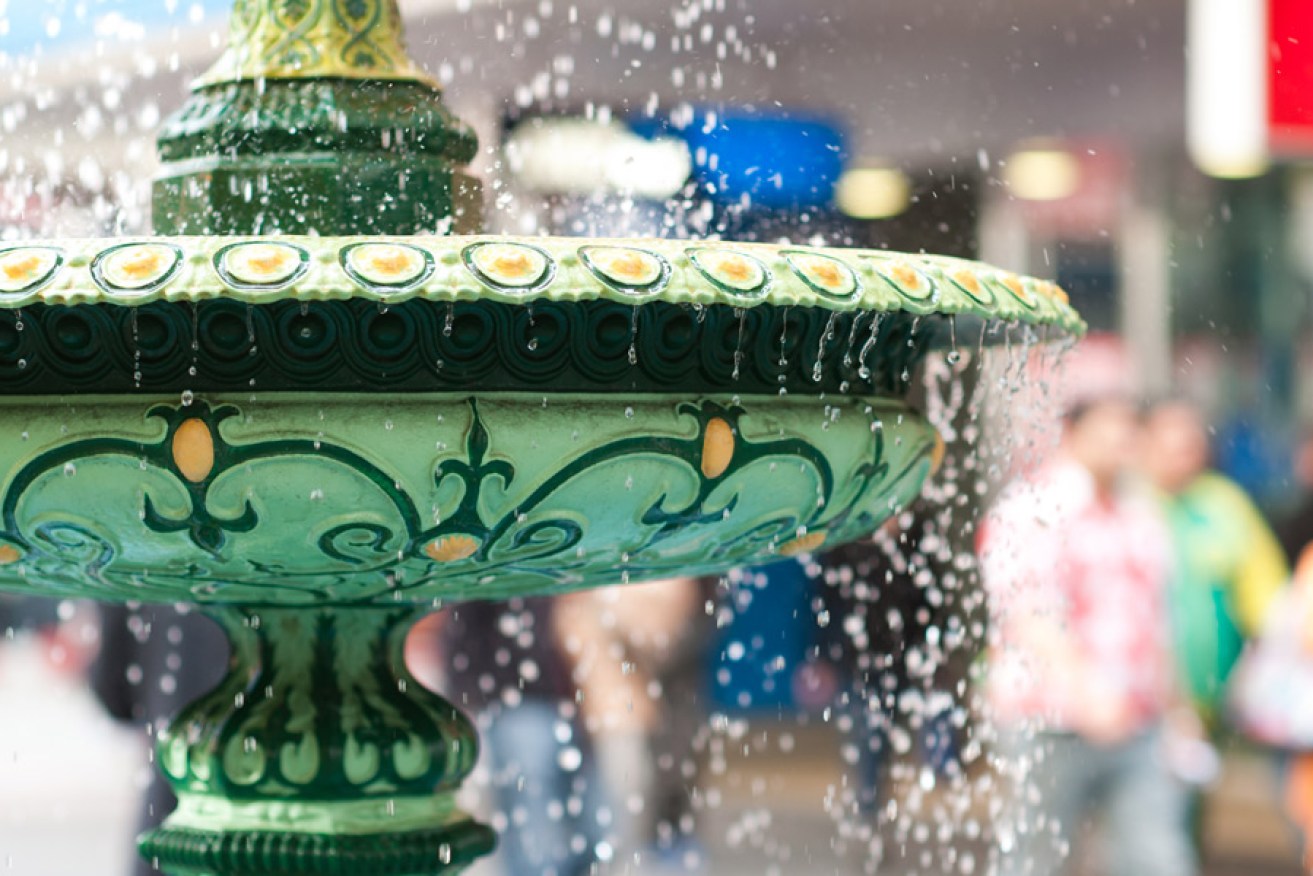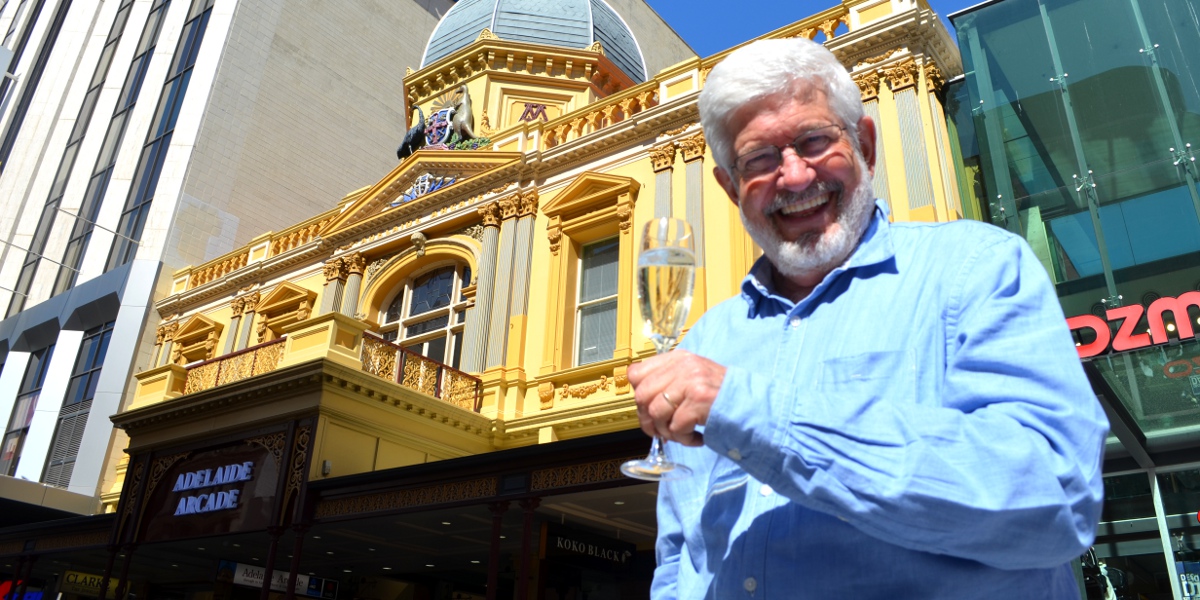Rundle Mall fountain’s bubbly birthday

The Rundle Mall fountain flowed with champagne when Don Dunstan opened the pedestrian retail strip on this day in 1976. Photo: Nat Rogers/InDaily
September 1, 1976, marked much more than the coming of spring to Adelaide. It was the day when the champagne flowed from the newly placed Victorian-era fountain at the corner of Gawler Place and the brand new Rundle Mall.
The intersection is a good starting point for our second stroll along Adelaide’s premier retail strip with the plan to look skywards to find symbols of boom times past.
Before we take off, we stare into … space. The section of Gawler Place on the North Terrace side is noticeably wider than the street on the southern side of the Mall. That’s because we can no longer look up at the old York picture theatre. Long and tall and narrow, it could house 1700 cinema-goers from 1921 until it was demolished in 1960 as part of a City Council road-widening project.
This crossroad is now undergoing more cosmetic surgery. The first upgrade of the 1976 Mall came in the 1990s. The fountain was moved towards the hills and a new glass canopy installed. That has just been demolished, too, and we will soon look up to a new sound-shell roof over a stage set just to the north, off the pedestrian area.
As we get moving, look above the verandahs on one side of the Mall to the name under the parapet. It’s now called the Walsh Building, but for many years it was the Orient Hotel. There was a pub on this corner as far back as 1840, when the Hamburg Hotel was offering a bed and a feed to early colonists. Its current look dates back to the 1920s, when changes in legislation allowed for extensive concrete construction. The architect for that major upgrade to five storeys – with art deco leafy scrolls – was Kenneth Milne, who designed the famous Adelaide Oval scoreboard.
Heading east towards the blue backdrop of the Adelaide Hills, long-time visitors will spare a thought for the countless cups of tea and Kitchener buns consumed in the pretty, 1920s, glass-fronted Balfours building on the left. Again, look out for the name on high. I ducked in for the occasional vanilla slice myself before its demise.
Surely South Australia’s most-photographed piece of public art, the “Mall’s Balls”* provide our next focal point. Almost every visitor looks up at the stainless-steel spheres, and so should we. They were designed by Vienna-born Australian artist Bert Flugelman, who was head of sculpture at SA’s Art School when it was commissioned. His best-known work was a gift from the now-defunct Hindmarsh Building Society to celebrate its centenary in 1977.
As it happens, the sculpture is in the midst of some of the area’s best architectural artistry as well. Newcomers could not miss the extravagant renaissance architecture above the Regent Arcade, but they might wonder how it all happened. The answer lies in far-off Hollywood. In 1928, “Australia’s most luxurious theatre” was built to house all of 2298 patrons, craving the latest silent movies.
The Regent facade was all about the glamour of the film industry. It was even more elaborate and stylish inside. The picture theatre was the home of the mighty Wurlitzer organ, with an American performer engaged to play it for the first three months. It now graces the Memorial Hall at St Peter’s College. Suitably, a grand charity variety show filled the stage on the Regent’s last glorious night as a grand cinema in 1967. A smaller version survived until 2004.
With Adelaide’s only surviving dome reaching for the sun, its classical 19th-century neighbour adds an extra touch of class in this part of our rubber-necking stroll. When it was opened in 1885, complete with a band playing “The Adelaide Arcade Polka” composed for the occasion, it was ranked as one of the great arcades of Australia.
Its owners were justly proud of its cast-iron structure and decoration, imported plate glass and in-house electricity generator. The Adelaide Arcade style was Italianate Renaissance architecture revival writ large, but it also tried for a local touch. Below the dome, look for an early version of an Australian Coat of Arms, many years before Federation in 1901. At least they got the kangaroo and the emu right. The arcade still stands as a magnificent symbol of a copper mining boom in South Australia and the good times before the troubled 1890s.
There is a delicious choice of coffee shops around the fountain that moved up the Mall to sit symmetrically in front of the Arcade, so take a break and soak up the heritage around you.
The final installment of InDaily’s “looking up” stroll along Rundle Mall with Keith Conlon will appear soon.
READ PART ONE: Keith Conlon presents: look up in Rundle Mall
*The Mall’s Balls and the Rundle Mall Fountain have temporarily disappeared during the mall’s renovations. The Balls will return later this month, while the fountain is set to be re-installed in October.




